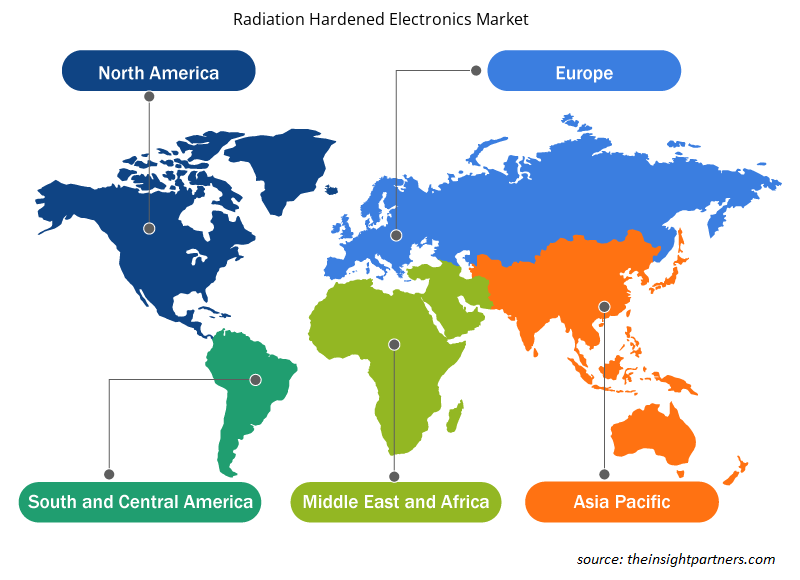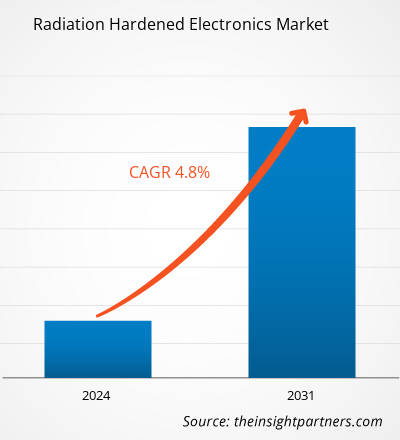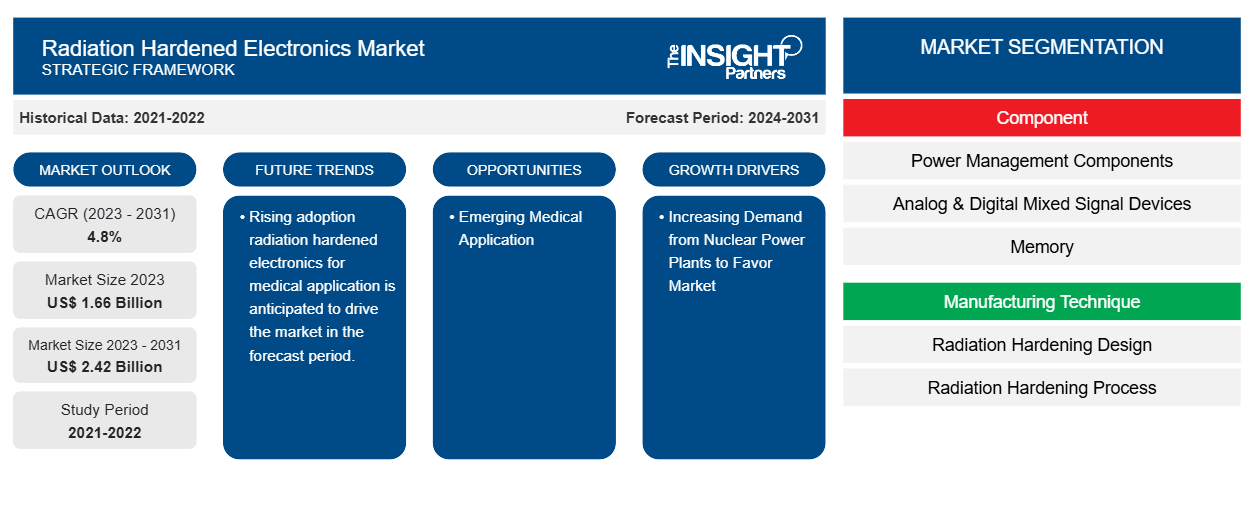Se prevé que el tamaño del mercado de productos electrónicos reforzados contra la radiación alcance los 2.420 millones de dólares estadounidenses en 2031, frente a los 1.660 millones de dólares estadounidenses en 2023. Se espera que el mercado registre una CAGR del 4,8 % durante el período 2023-2031. Es probable que la creciente adopción de productos electrónicos reforzados contra la radiación y el aumento de la inversión en programas espaciales sigan siendo tendencias e impulsores clave del mercado.
Análisis del mercado de productos electrónicos resistentes a la radiación
Se espera que la creciente demanda de sensores de retroalimentación reforzados contra la radiación entre los fabricantes de equipos y sistemas críticos de todo el mundo impulse el mercado de sensores de retroalimentación reforzados contra la radiación durante el período de pronóstico. Los sensores de retroalimentación reforzados contra la radiación están ampliamente integrados en sistemas aeroespaciales y de defensa, naves espaciales, satélites, sondas espaciales, equipos médicos y otros. Los avances tecnológicos, la miniaturización de los sensores de retroalimentación reforzados contra la radiación, la creciente demanda de energía renovable y el aumento de las actividades de I+D están impulsando el mercado de sensores de retroalimentación reforzados contra la radiación.
Descripción general del mercado de productos electrónicos reforzados contra la radiación
Los sensores de retroalimentación reforzados contra la radiación son dispositivos diseñados para soportar altos niveles de radiación, que se encuentran con mayor frecuencia en entornos nucleares y espaciales. Estos sensores emplean un mecanismo de retroalimentación para monitorear continuamente su desempeño y ajustarlo en consecuencia, asegurando operaciones confiables y precisas en radiaciones fuertes. Los sensores utilizan bucles de retroalimentación para detectar cualquier desviación de su comportamiento esperado causada por daños inducidos por la radiación.
Personalice este informe según sus necesidades
Obtendrá personalización en cualquier informe, sin cargo, incluidas partes de este informe o análisis a nivel de país, paquete de datos de Excel, así como también grandes ofertas y descuentos para empresas emergentes y universidades.
-
Obtenga las principales tendencias clave del mercado de este informe.Esta muestra GRATUITA incluirá análisis de datos, desde tendencias del mercado hasta estimaciones y pronósticos.
Impulsores y oportunidades del mercado de productos electrónicos resistentes a la radiación
La creciente demanda de centrales nucleares favorecerá el mercado
Las centrales nucleares generan electricidad mediante el proceso de fisión nuclear. En este proceso, se produce una cantidad significativa de energía, que genera una cantidad sustancial de radiación. Esta radiación es dañina para los humanos y puede dañar los equipos electrónicos, lo que aumenta la demanda de sensores de retroalimentación reforzados contra la radiación. Los sensores de retroalimentación reforzados contra la radiación se colocan estratégicamente en toda la planta para monitorear las variaciones de temperatura en áreas críticas, como los sistemas de refrigeración, el núcleo del reactor y varios componentes. Estos sensores brindan retroalimentación continua a los sistemas de control, lo que permite a los operadores de la planta tomar las medidas necesarias para mantener el rango de temperatura deseado y tomar decisiones informadas para mejorar el rendimiento del sistema. Varias empresas están realizando inversiones significativas en el desarrollo de centrales eléctricas. Por ejemplo, según los datos del Departamento de Energía de los EE. UU. (DOE) publicados en enero de 2024, el DOE invirtió aproximadamente US$ 12 mil millones en Plant Vogtle para proporcionar más de 1100 megavatios de energía limpia a la red una vez que esté en funcionamiento.Vogtle to provide more than 1,100 megawatts of clean power to the grid once in operation.
Aplicación médica emergente.
Los sensores de retroalimentación reforzados contra la radiación desempeñan un papel crucial para garantizar la seguridad, la precisión y la confiabilidad de los equipos médicos utilizados en la industria de la salud. Estos sensores se integran en una variedad de equipos médicos, incluidos los rayos gamma, los rayos X y los haces de electrones, al hacerlos soportar altos niveles de radiación. Los sensores de retroalimentación reforzados contra la radiación se integran principalmente en los equipos de radioterapia para ayudar a los médicos a tratar a los pacientes con cáncer. La radioterapia , también conocida como radioterapia, es el modo de tratamiento más común para los pacientes con cáncer, en el que se utilizan haces de radiación de alta energía para apuntar y destruir las células cancerosas, que requieren sensores de retroalimentación reforzados contra la radiación para monitorear varios parámetros, incluida la administración de dosis, la densidad del haz y el posicionamiento del haz. Los profesionales de la salud utilizan sensores de retroalimentación reforzados contra la radiación para garantizar la administración de un tratamiento preciso y exacto al minimizar el daño a los tejidos sanos. Por ejemplo, en abril de 2022, Maxon Group presentó los codificadores ENX GAMA diseñados para su uso en las proximidades de aceleradores lineales médicos en equipos como colimadores de múltiples hojas. Los codificadores ENX GAMA son codificadores resistentes a la radiación integrados con motores de CC que son muy adecuados para dispositivos de radioterapia.Maxon Group introduced ENX GAMA encoders designed for use in the vicinity of medical linear accelerators on equipment such as multi-leaf collimators. ENX GAMA encoders are radiation-resistant encoders integrated with DC motors that are highly suitable for radiotherapy devices.
Análisis de segmentación del informe de mercado de electrónica reforzada con radiación
Los segmentos clave que contribuyeron a la derivación del análisis del mercado de electrónica reforzada con radiación son los componentes, la técnica de fabricación y las aplicaciones.
- Según los componentes, el mercado de productos electrónicos resistentes a la radiación se divide en componentes de gestión de energía, dispositivos de señal mixta analógicos y digitales, memorias, controladores y procesadores. Se prevé que el segmento de componentes de gestión de energía tenga una participación de mercado significativa en el período de pronóstico.
- Según la técnica de fabricación, el mercado de productos electrónicos endurecidos por radiación se divide en endurecimiento por radiación por diseño (RHBD) y endurecimiento por radiación por proceso (RHBP). Se prevé que el segmento de endurecimiento por radiación por diseño (RHBD) tenga una participación de mercado significativa en el período de pronóstico.
- Por aplicaciones, el mercado está segmentado en aeroespacial y defensa, plantas de energía nuclear, espacio y otros. Se prevé que el sector aeroespacial y de defensa ocupe una cuota de mercado significativa en el período de pronóstico.
Análisis de la cuota de mercado de productos electrónicos resistentes a la radiación por geografía
El alcance geográfico del informe del mercado de electrónica endurecida por radiación se divide principalmente en cinco regiones: América del Norte, Asia Pacífico, Europa, Medio Oriente y África, y América del Sur y Central.
América del Norte ha dominado el mercado de la electrónica reforzada con radiación. La creciente industria espacial está impulsando el mercado de sensores de retroalimentación reforzados con radiación en América del Norte. Estados Unidos ha estado a la vanguardia de los vuelos espaciales durante más de 60 años. Tiene el programa espacial gubernamental más grande del mundo. Los satélites registrados en Estados Unidos representaron más de la mitad de todos los satélites operativos en 2022. Estados Unidos es actualmente el único país con una cuenta temática para actividades espaciales. Además, un fuerte énfasis en la investigación y el desarrollo en las economías desarrolladas de Estados Unidos y Canadá está obligando a los actores norteamericanos a traer soluciones tecnológicamente avanzadas al mercado. Además, Estados Unidos tiene un gran número de actores del mercado de la electrónica reforzada con radiación que se han centrado cada vez más en el desarrollo de soluciones innovadoras. Todos estos factores contribuyen al crecimiento de la región del mercado de la electrónica reforzada con radiación.
Perspectivas regionales del mercado de productos electrónicos reforzados contra la radiación
Los analistas de Insight Partners explicaron en detalle las tendencias y los factores regionales que influyen en el mercado de productos electrónicos reforzados contra la radiación durante el período de pronóstico. Esta sección también analiza los segmentos y la geografía del mercado de productos electrónicos reforzados contra la radiación en América del Norte, Europa, Asia Pacífico, Oriente Medio y África, y América del Sur y Central.

- Obtenga datos regionales específicos para el mercado de productos electrónicos reforzados contra la radiación
Alcance del informe de mercado de productos electrónicos reforzados contra la radiación
| Atributo del informe | Detalles |
|---|---|
| Tamaño del mercado en 2023 | 1.660 millones de dólares estadounidenses |
| Tamaño del mercado en 2031 | US$ 2,42 mil millones |
| CAGR global (2023 - 2031) | 4,8% |
| Datos históricos | 2021-2022 |
| Período de pronóstico | 2024-2031 |
| Segmentos cubiertos |
Por componente
|
| Regiones y países cubiertos |
América del norte
|
| Líderes del mercado y perfiles de empresas clave |
|
Densidad de actores del mercado: comprensión de su impacto en la dinámica empresarial
El mercado de productos electrónicos reforzados contra la radiación está creciendo rápidamente, impulsado por la creciente demanda de los usuarios finales debido a factores como la evolución de las preferencias de los consumidores, los avances tecnológicos y una mayor conciencia de los beneficios del producto. A medida que aumenta la demanda, las empresas amplían sus ofertas, innovan para satisfacer las necesidades de los consumidores y aprovechan las tendencias emergentes, lo que impulsa aún más el crecimiento del mercado.
La densidad de actores del mercado se refiere a la distribución de las empresas o firmas que operan dentro de un mercado o industria en particular. Indica cuántos competidores (actores del mercado) están presentes en un espacio de mercado determinado en relación con su tamaño o valor total de mercado.
Las principales empresas que operan en el mercado de productos electrónicos reforzados con radiación son:
- Sistemas BAE
- Corporación de dispositivos de datos
- Compañía: Honeywell International Inc.
- Tecnologías Infineon AG
- Corporación Electrónica Renesas
- Texas Instruments Incorporated
Descargo de responsabilidad : Las empresas enumeradas anteriormente no están clasificadas en ningún orden particular.

- Obtenga una descripción general de los principales actores clave del mercado de productos electrónicos reforzados contra la radiación
Noticias y desarrollos recientes del mercado de productos electrónicos resistentes a la radiación
El mercado de productos electrónicos reforzados contra la radiación se evalúa mediante la recopilación de datos cualitativos y cuantitativos posteriores a la investigación primaria y secundaria, que incluye publicaciones corporativas importantes, datos de asociaciones y bases de datos. A continuación, se enumeran algunos de los avances en el mercado de productos electrónicos reforzados contra la radiación:
- EPC Space presentó el EPC7009L16SH, un CI controlador de compuerta de nitruro de galio (GaN) endurecido por radiación. Este innovador controlador de GaN, que utiliza la exclusiva tecnología de CI eGaN de EPC, permite a los ingenieros de diseño aprovechar al máximo las capacidades de la tecnología FET eGaN. (Fuente: EPC Space, sitio web de la empresa, abril de 2024)
- Renesas Electronics Corporation, un proveedor de soluciones avanzadas de semiconductores, lanzó una nueva línea de dispositivos endurecidos por radiación (rad-hard) con encapsulado de plástico para sistemas de gestión de energía satelital. Los cuatro nuevos dispositivos incluyen el regulador reductor de punto de carga (POL) ISL71001SLHM/SEHM, los aisladores digitales ISL71610SLHM e ISL71710SLHM, y el transistor de efecto de campo GaN de 100 V ISL73033SLHM y el controlador de lado bajo integrado. (Fuente: Renesas Electronics Corporation, sitio web de la empresa, julio de 2021)
Informe de mercado sobre electrónica reforzada contra la radiación: cobertura y resultados
El informe “Tamaño y pronóstico del mercado de electrónica reforzada con radiación (2021-2031)” proporciona un análisis detallado del mercado que cubre las siguientes áreas:
- Tamaño y pronóstico del mercado de electrónica reforzada con radiación a nivel global, regional y nacional para todos los segmentos clave del mercado cubiertos por el alcance.
- Tendencias del mercado de electrónica reforzada con radiación, así como dinámica del mercado, como impulsores, restricciones y oportunidades clave.
- Análisis detallado PEST/Cinco fuerzas de Porter y FODA.
- Análisis del mercado de electrónica endurecida por radiación que cubre las tendencias clave del mercado, el marco global y regional, los principales actores, las regulaciones y los desarrollos recientes del mercado.
- Análisis del panorama de la industria y la competencia que cubre la concentración del mercado, el análisis de mapas de calor, los actores destacados y los desarrollos recientes para el mercado de electrónica reforzada con radiación.
- Perfiles detallados de empresas.
- Análisis histórico (2 años), año base, pronóstico (7 años) con CAGR
- Análisis PEST y FODA
- Tamaño del mercado, valor/volumen: global, regional y nacional
- Industria y panorama competitivo
- Conjunto de datos de Excel
Informes recientes
Testimonios
Razón para comprar
- Toma de decisiones informada
- Comprensión de la dinámica del mercado
- Análisis competitivo
- Información sobre clientes
- Pronósticos del mercado
- Mitigación de riesgos
- Planificación estratégica
- Justificación de la inversión
- Identificación de mercados emergentes
- Mejora de las estrategias de marketing
- Impulso de la eficiencia operativa
- Alineación con las tendencias regulatorias























 Obtenga una muestra gratuita para - Mercado de electrónica reforzada con radiación
Obtenga una muestra gratuita para - Mercado de electrónica reforzada con radiación